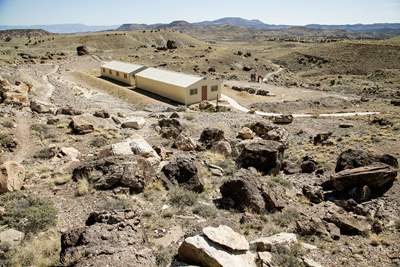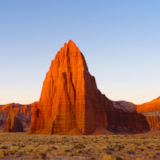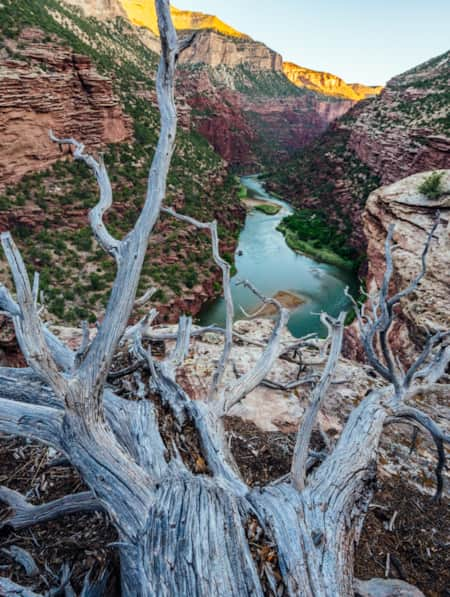Hidden Secrets of the Jurassic National Monument's Cleveland-Lloyd Dinosaur Quarry
The Cleveland-Lloyd Dinosaur Quarry at Jurassic National Monument is an opportunity to learn about prehistoric animals and see a working paleontologist dig.

About 150 million years ago, the landscapes within the modern-day San Rafael Swell in Utah's Emery County looked much different than they do today. In place of the sparsely distributed junipers and pinyon pines, there were lush forests filled with ferns and ginkgo trees. In place of the vast, open desert, there was an inland sea. In place of small, scurrying lizards, there were mighty dinosaurs. (Read: A Deep Dig into Utah's Deep Time)
Origins of the Cleveland-Lloyd Dinosaur Quarry
Before the days of Tyrannosaurus rex, during the Late Jurassic period (around 145 million years ago), the Allosaurus fragilis was the top dog.
These fierce predators had serrated, blade-like teeth that could tear through the flesh of their prey, which included almost every other dinosaur of the Morrison Formation ecosystem in which it lived. Juvenile Allosauruses hunted en masse, helping each other to chase down their dinners.
One fatal day, a troop of Allosaurus followed some Stegosauruses stenops down to a muddy flood pond — and into a so-called “predator trap.” They all got stuck for good, thus creating what would one day become known as the Cleveland-Lloyd Dinosaur Quarry, one of the biggest known ancient dinosaur graveyards in the world.
Or so some theories suggest. In truth, the questions of why so many dinosaur remains have been uncovered at the Cleveland-Lloyd Dinosaur Quarry in Jurassic National Monument — more than 12,000 individual bones, belonging to at least 74 individual dinosaurs — and why so many of those bones belonged to Allosaurus in particular, are still mysteries. Other hypotheses include that the bones concentrated here after floating downstream from somewhere else and even the possibility of poisoned water.
However it came to be that the bones were deposited there, visiting the Cleveland-Lloyd is an opportunity to learn about these prehistoric animals. And, as it is a working quarry, a visit could also be a unique chance to see some paleontologists at work — and perhaps even leave with some paleontological theories of your own.
"A visit could also be a unique chance to see some paleontologists at work — and perhaps even leave with some paleontological theories of your own"

More than 12,000 individual bones, belonging to at least 74 individual dinosaurs, have been recovered at Cleveland-Lloyd Dinosaur Quarry.

A full Allosaurus skeleton, nicknamed “Al”, has been on display at Cleveland-Lloyd Dinosaur Quarry since June 1963 (and was remounted in 2013).
Science in the Swell
No one knows who first discovered the quarry, but the fact that ancient bones could be uncovered there was common knowledge amongst the cowboys who took their herds through the remote and rugged San Rafael Swell in the late 19th Century. The first official study was carried out in 1927 when geologists from the University of Utah visited and collected about 800 bones.
In 1939, William Lee Stokes, a Utah native and student at Princeton University, led a group of colleagues to begin further excavations: Over three summers, they collected 1,200 bones. About two-thirds of these bones belonged to Allosauruses, but there was evidence of other known species, including Stegosaurus and Torvosaurus. In 1974, however, James H. Madsen, Jr., a geologist at the University of Utah, made history by discovering a new species of dinosaur, the Stokesosaurus clevelandi. Then, two years later, he did it again with his discovery of the Marshosaurus bicentesimus.
Still, at Cleveland-Lloyd, the Allosaurus remains the shining star. A full Allosaurus skeleton, nicknamed “Al”, has been on display since June 1963 (and was remounted in 2013). Standing at 6.5 feet tall and 28 feet long, Al is truly a sight to behold. What’s more, he offers hints at what he and his kin were like when they had flesh on their bones. The long tail of the Allosaurus — almost 60 percent of its entire length — is thought to have served as a counterbalance to the animal’s heavy body. Their bodies were built for the hunt: in addition to their sharp teeth, their strong jaw muscles could generate almost a ton of force. Their necks had a ball-and-socket that allowed them to swivel their large heads (Al’s skull is 28 inches long), and strong ligaments so they could throw their heads back to swallow down whole chunks of fresh meat.
But Al isn’t the only dinosaur you’ll meet at the Dinosaur Quarry. The collection includes a full skeleton of a Stegosaurus stenops, made up of a mix of real and casted bones. The spikes that run along this dinosaur species’ back and tail make it easily recognizable, and a popular favorite. This herbivore also made for a favorite meal amongst Allosauruses. Additionally, the museum has a skeleton of a Camarasaurus lentus and a Camptosaurus dispar, two other herbivorous species of the Morrison Formation.
One of the cooler things at the museum doesn’t signify death at all — but, rather, life. The fossilized dinosaur egg on display was uncovered at the quarry in 1987. At that time, it was the oldest dinosaur egg ever found.
Visiting the Quarry
There is a small fee to enter the Quarry or it's covered by an America the Beautiful pass. Take time to engage with the curators and staff and bring a lunch for a picnic. Cleveland-Lloyd also has a couple of short hiking trails on its premises, which make for a great way to stretch your legs after perusing the museum’s exhibits. Be sure to walk with your eyes open and your wits about you: If you’re paying attention, you might come across the quarry’s next big discovery.
Jurassic National Monument is open daily during the summer, Thursday-Saturday during the spring and fall, and is closed from the end of October to mid-March. Unpaved BLM roads to the Cleveland-Lloyd Dinosaur Quarry can become impassable after a storm, so check conditions.

















